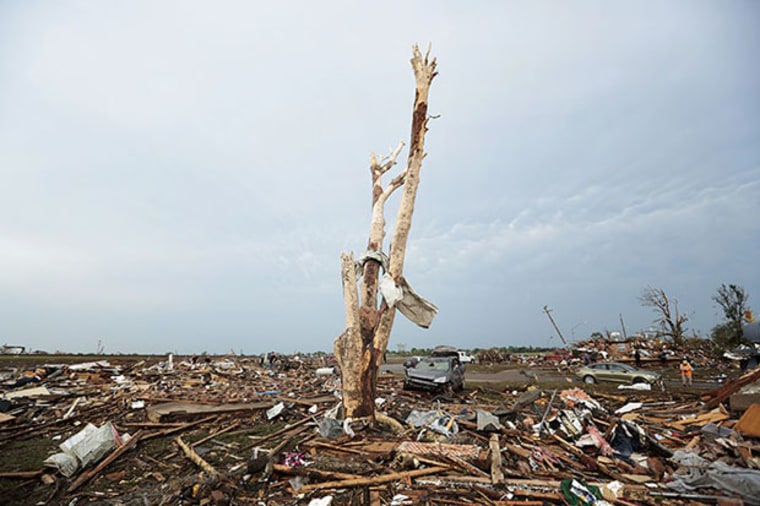The economic hit from the deadly tornadoes that struck Oklahoma Monday could run as high as $2 billion, with the federal government potentially on the hook for more than $100 million—at a time when FEMA is already strapped for cash thanks to the sequester. But the agency will have the resources it needs to fulfill its most critical functions, a former FEMA COO says.
Still, the havoc wreaked by Monday’s twister, which has killed dozens, has put the state’s conservative lawmakers in an awkward spot when it comes to backing federal funding for the aid effort. Oklahoma’s two senators, Republicans Tom Coburn and James Inhofe, both opposed Sandy relief and backed an amendment that would have cut the package.
On Monday night, a spokesman for Coburn, John Hart, told the Huffington Post that the senator will aim to ensure that funding for tornado relief will be offset by cuts to the federal budget elsewhere. “That's always been his position,” Hart said.
A a memo from Coburn's office released Tuesday read: "It is crass for critics to play disaster aid politics when first responders are pulling victims from the rubble," his office said in a memo to reporters."
In an interview on msnbc on Tuesday, Inhofe rejected comparisons between the Sandy aid package and relief funding for Oklahoma.
“It’s totally different,” he told Chris Jansing. “They had things in the Virgin Islands, they were fixing roads there, putting roofs on houses in Washington DC. Everyone was getting in and exploiting the tragedy that took place. That won’t happen in Oklahoma.”
FEMA isn’t exactly flush right now. The sequester cut around $1 billion from the agency's budget, about a tenth of the agency’s total budget. And concerns about federal spending—justified or not—have made Congressional support for supplemental disaster relief funding far from routine lately. A relief package for victims of Hurricane Sandy at first failed to pass the House, with some lawmakers raising concerns about what they saw as unrelated spending in the bill.
“Oklahoma needs to get what it needs right away,” President Obama said Tuesday morning, as FEMA director Craig Fugate made his way to the disaster scene. On Monday, Obama signed a formal disaster declaration, opening the door for federal help.
“We will work with the administration to ensure the people of Oklahoma get the assistance they need,” Speaker John Boehner told reporters Tuesday.
Exactly what that is, in terms of federal dollars, is unclear.
“We don’t even know what we need at this point," Rep. James Lankford of Oklahoma told msnbc's Chuck Todd Tuesday morning.
Ken Burris, who served as FEMA’s chief operating officer during the Bush administration, told msnbc in a phone interview that it could be months until the price tag emerges.
“We may be into the new fiscal year [which starts in July] before the true cost of the tornadoes is really figured out,” Burris said. “That process is still ongoing with the [Hurricane] Sandy programs.”
Sandy struck nearly seven months ago.
Kinetic Analysis, which uses computer modeling and analysis to predict losses from natural disasters, put the total damage in Oklahoma at between $1.2 billion and $2 billion, CNBC has reported. And a 1999 tornado that hit the same central Oklahoma region and killed 36 cost a total of $1.1 billion in today’s dollars. Local officials have said the damage from Monday’s tornado appears worse.
But FEMA’s share of the relief costs will likely be far lower. Of the 173 emergency declarations between 1999 and 2009, the average hit to the agency’s disaster relief fund was around $9.2 million, based on figures reported by USA Today. The 1999 Oklahoma tornadoes cost FEMA more than $67.8 million in grants and loans to help victims.
As of Tuesday morning, the agency had $11.8 billion in its disaster relief account, a senior aide to the House Appropriations Committee told The Wall Street Journal, adding that $6.2 billion could be added as part of the routine appropriations process.
Burris said the agency would be able to fund the most critical relief functions— emergency protective measures and life-saving measures, known as Categories A and B—if necessary by having Congress approve supplemental funding.
“Have payments been delayed on a school or some public infrastructure project that’s been under construction for five or six years? Yes,” said Burris. “But FEMA always meets its obligations in Categories A and B. Always. The president’s not going to let that happen.”
Coburn has been a consistent advocate of limiting FEMA’s budget. When Homeland Security Secretary Janet Napolitano said in March that the sequester could undermine DHS’ “core critical mission,” Coburn pushed back.
"[T]he Office of Management and Budget projected that at the end of fiscal year 2013, DHS would carry forward more than $9 billion in unobligated balances," Coburn wrote in a letter to Napolitano. "This is money that has not yet been spent, nor even assigned to a specific project, raising the question of why we would not start by reclaiming these funds.”
Late Update, 2:19pm: White House press secretary Jay Carney said Tuesday afternoon: "We have been pleased to work with Congress and we've been pleased by the fact Congress allowed us to do what is needed in situations like this. That means being able to respond to the state's needs and, right now, FEMA has sufficient resources to do that. Further assessments obviously will be forthcoming."
